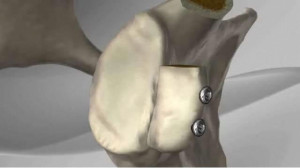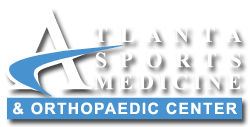Latarjet Protocol
 Anterior Stabilization of the Shoulder: Latarjet Protocol
Anterior Stabilization of the Shoulder: Latarjet Protocol
Shoulder instability has multiple etiologies including congenital deformity, recurrent overuse activity, and/or traumatic dislocation. Surgical stabilization of the glenohumeral joint is indicated after conservative treatment fails and recurrent instability/subluxation continues. A number of different surgical procedures exist for anterior stabilization and the surgical treatment depends on concomitant pathology including bone loss, revision, and tissue laxity.
Rehabilitation Considerations
With the Latarjet procedure, early postoperative therapy must protect the subscapularis and the developing bony union of the coracoid process. This typically takes around 6-8 weeks and the biceps and coracobrachialis must be protected during this time. Therefore, aggressive shoulder extension and external rotation stretching is not advocated in the immediate postoperative period. External rotation should be gradual allowing the anterior structures to heal.
Because of surgical technique and early immobilization, the subscapularis is affected in terms of length, force production, and proprioception. Hence, specific therapy directed towards the subscapularis later is essential, working on both the upper and lower fibers.
The purpose of this protocol is to provide the physician, therapist, and patient with a GUIDELINE of the postoperative rehabilitation after the Latarjet procedure.
Phase I – Immediate Post Surgical Phase (Weeks 1-6)
Goals:
-Minimize shoulder pain
-Decrease inflammation
-Protect repair
-Achieve PROM
Precautions/Patient Education:
-No active range of motion (AROM)
-No excessive ER stretching (stop at end feel)
-Sling at all times, shower with arm in adducted position
-No lifting, pushing, pulling
Activity
-Motion (FF to tolerance, ER to 25-30 degrees starting with 30 degrees of abduction, IR to 45 degrees with 30 degrees of abduction – all in scapular plane)
-Ball squeezes
-Prevent shoulder extension with pillow behind elbow
-Cryotherapy to decrease inflammation
Criteria for Phase II progression:
-Compliance with precautions and immobilization guidelines
-100 deg FF, 30 deg ER, 20-30 deg abduction
-Minimal or no pain with exercises
Phase II – Intermediate Phase/ROM (approximately Week 6-9)
Goals:
-Protect surgical repair
-Obtain AROM
-Discontinue sling by week 4-5
-Start light waist level activities
Precautions:
-Must have most PROM and good mechanics
-No pushing, pulling, lifting
-No excessive ER or stretching
-Avoid activities with excessive load on anterior structures: pushups, flys, etc)
Early Phase II (approximately week 6):
-Motion (FF to tolerance, ER to 45 with 30 deg abduction, IR to 45 with 30 deg abduction)
-Mobilize glenohumeral joint if decreased ROM. Only mobilize in directions of limited motion, address scapulothoracic and trunk mobility limitations as well.
-Start post capsule stretching
Late Phase II (approximately Week 9):
-Cont PROM
-FF, IR, abduction to tolerance
-ER progression, may progress once >35 deg ER at 0-40 abduction
-Strengthen scapular retractors and upward rotators
-Initiate balanced AROM program
-Low dynamic position first
-No pulling, pushing, lifting
-Exercises should be pain free
-No substitution
-Open and closed chain exercises
Criteria for progression to phase III:
-Passive FF to 80% of contralateral shoulder
-Passive ER within 10-15 degrees of contralateral shoulder at 20 deg abd
-Passive ER of at least 75 degrees in 90 degrees abduction
-Good shoulder mechanics
-No pain
Phase III – Strengthening Phase (approximately Week 10 – Week 15)
Goals:
-Improve strength, endurance, neuromuscular control
Precautions:
-Avoid aggressive overhead activities/strengthening
-Avoid contact sports/activities
-No strengthening until near full ROM
Activity:
-Continue AROM
-Start biceps curls with light resistance
-Start pec major strengthening
-Start subscapularis strengthening
-Push up plus (counter, wall, knees on floor)
-IR resistive band
-Forward punch
Phase IV – Overhead Activities Phase / Return to activity phase (approximately Week 16-20)
Goals:
-Return to full work and recreational activities
Precautions:
-Avoid stressing anterior capsular structures
-“Always see your elbows” exercises (avoid bench, dips, lat pulls behind shoulders)
-No throwing or overhead activities until cleared by MD
Activity:
-Progressive isotonic strengthening with no substitution
-Progressive lifting program (focus on pec, lat, deltoid)
-Light weight with higher reps
-Patients can usually return to sport by 5-6 months if no pain, full motion, full strength, or when cleared by MD
Protocol modified and used with permission from BWH Sports/Shoulder Service.
